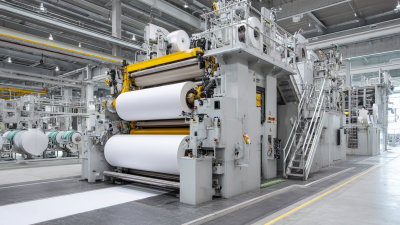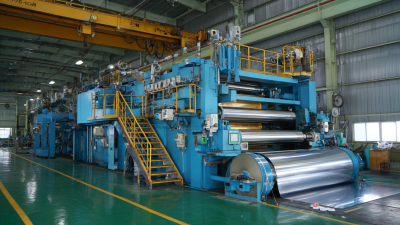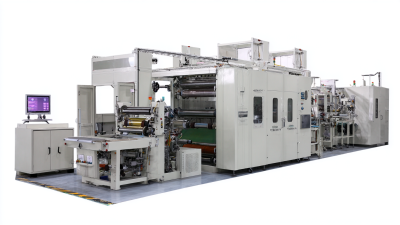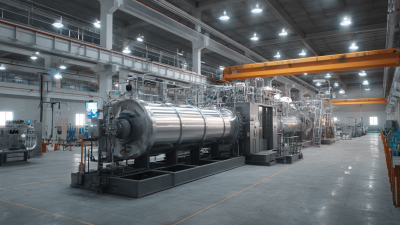
As the world increasingly prioritizes sustainability, the printing industry is positioned at a unique crossroads of innovation and responsibility. Recent industry reports indicate that the global paper coating machine market is projected to grow at a CAGR of 5.2% from 2021 to 2028, with an anticipated market value of nearly $1.4 billion by the end of this period. This growth is fueled by the rising demand for environmentally friendly printing solutions that do not compromise on quality.
According to Dr. Emily Carson, an industry expert in paper technology, “The evolution of paper coating machines is pivotal in reducing the carbon footprint of the printing process while enhancing product durability.” These machines not only improve the visual appeal of printed materials but also enable the use of biodegradable and recyclable materials, aligning with the broader goals of sustainability. The continuous advancements in coating technologies promise to redefine the capabilities of printing, making it more efficient and eco-conscious than ever before.
In this context, the following discussion highlights the "Top 5" innovations in sustainable printing driven by paper coating machines, showcasing how these advancements are not only meeting industry needs but also paving the way for a greener future.

The realm of paper coating technologies is witnessing a transformative shift towards sustainability, driven by the emergence of innovative eco-friendly solutions. Recent advancements in coating machines have integrated environmentally conscious practices, ensuring that printing processes minimize their ecological footprint. These new machines utilize biodegradable materials and water-based coatings, reducing reliance on harmful chemicals that have traditionally been associated with the printing industry.
Additionally, the rise of digital printing techniques has propelled the development of advanced paper coating machines that enhance the quality while maintaining sustainability. These innovations not only optimize the coating application process but also improve efficiency, allowing for less waste during production. As manufacturers adopt these emerging technologies, they contribute to a circular economy by enabling recycling and reuse of materials, promoting a more sustainable printing landscape that prioritizes ecological responsibility.
The printing industry is experiencing a significant shift towards sustainability, driven by innovations in paper coating technologies. According to industry reports, around 80% of printing companies are now prioritizing eco-friendly practices, with a focus on materials and processes that reduce environmental impact. This transition is not just a trend but a necessity; the global demand for sustainable printing solutions is projected to grow by over 15% annually as businesses and consumers alike seek greener alternatives.
Key innovations include advanced coating technologies that enable printers to utilize recycled and organic materials without compromising quality. Startups are at the forefront of these developments, with more than 20 companies emerging in the last year alone, dedicated to sustainable printing solutions. These businesses are leveraging cutting-edge research and development to create coatings that enhance the durability and printability of eco-friendly materials, ultimately reducing waste and energy consumption in the production process. As these innovations gain traction, they not only improve the sustainability of printing operations but also provide a competitive edge for businesses that embrace them.
| Innovation | Description | Impact on Sustainability | Implementation Year |
|---|---|---|---|
| Biodegradable Coatings | Development of coatings that decompose naturally without harming the environment. | Reduces landfill waste and promotes a circular economy. | 2023 |
| Water-Based Inks | Use of inks that contain no harmful solvents and are safe for the environment. | Minimizes air pollution and health risks to workers. | 2022 |
| Recyclable Coating Technologies | Innovations enabling printed materials to be completely recyclable. | Encourages recycling practices and supports sustainable waste management. | 2024 |
| Energy-Efficient Machines | State-of-the-art printing machines that lower energy consumption. | Reduces carbon footprint and operational costs. | 2023 |
| Digital Printing Advancements | Innovative digital printing methods that reduce material waste. | Increases efficiency and lessens the environmental impact of overproduction. | 2025 |
The growing awareness of environmental issues has led to a significant shift in the printing industry towards sustainable practices, particularly through the development of biodegradable coatings. These innovative coatings not only enhance the performance and durability of printed materials but also reduce their ecological impact. Traditional coatings often contribute to long-lasting waste; however, biodegradable options break down naturally, helping to alleviate pollution and the strain on landfills.
As businesses strive for sustainability, adopting biodegradable coatings can markedly improve their environmental footprint. For instance, brands that switch to such coatings demonstrate their commitment to long-term ecological health, appealing to environmentally conscious consumers. This transition not only aids in waste reduction but also positions these companies as leaders in innovation within their industries.
**Tips:** When considering biodegradable coatings, research the specific materials and their breakdown processes to fully understand their environmental benefits. Additionally, collaborate with suppliers who prioritize sustainability in their production methods to create a comprehensive green strategy for your printing needs. Lastly, communicate these sustainable practices to your customers to enhance brand loyalty and awareness.
Digital coating techniques are paving the way for resource efficiency in sustainable printing innovations. Unlike traditional methods, digital coatings utilize targeted applications that minimize waste and reduce the volume of materials needed. By precisely applying coatings only where necessary, these techniques not only enhance the quality of printed materials but also significantly cut down on excess resources, thereby promoting environmental sustainability.
Furthermore, digital coating processes allow for faster production times and greater customization. As brands increasingly seek to differentiate themselves in a competitive market, the ability to quickly adjust coating designs or apply special finishes on-demand becomes invaluable. This adaptability not only meets the immediate needs of consumers but also aligns with sustainable practices by reducing the need for large inventories and excessive production runs.
In essence, digital coating techniques represent a significant advancement in the printing industry, contributing to both economic efficiency and ecological responsibility.
The future of sustainable printing is being profoundly influenced by advancements in paper coating technologies, particularly through the utilization of innovative materials. As the global market for acrylic emulsions reached a value of $8.35 billion in 2022, projections indicate significant growth, with estimates suggesting an increase to $8.92 billion in 2023, and further expansion to $14.39 billion by 2030. This surge in demand reflects a growing awareness and prioritization of eco-friendly solutions within the printing industry, where new formulations are designed to enhance the performance of coatings while minimizing environmental impact.
At exhibitions like Interzum 2025, the emphasis on sustainability is palpable, showcasing the latest advancements in construction materials and eco-friendly decorative films. These innovations not only contribute to achieving a sustainable society but also illustrate the potential of cutting-edge printing technologies that utilize sustainable materials. As firms focus on reducing their carbon footprints and improving the recyclability of their products, the paper coating sector is poised to play a critical role in driving the shift towards a more sustainable future within the printing landscape.





